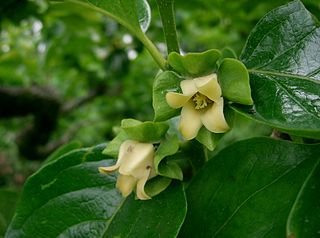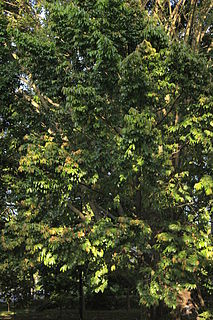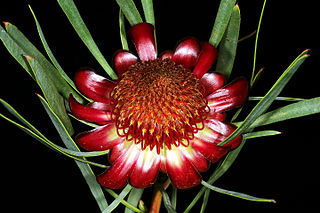
Diospyros is a genus of over 700 species of deciduous and evergreen trees and shrubs. The majority are native to the tropics, with only a few species extending into temperate regions. Individual species valued for their hard, heavy, dark timber, are commonly known as ebony trees, while others are valued for their fruit and known as persimmon trees. Some are useful as ornamentals and many are of local ecological importance. Species of this genus are generally dioecious, with separate male and female plants.

Diospyros celebica is a species of flowering tree in the family Ebenaceae that is endemic to the island of Sulawesi in Indonesia. The common name Makassar ebony is for the main seaport on the island, Makassar.

Terminalia acuminata is a tree species in the Combretaceae family. It was endemic to the Atlantic Forest in Brazil. The species was believed to be extinct in the wild from habitat loss, entering the IUCN Red List in 1998, with two individuals remaining in the Rio de Janeiro Botanical Garden.

Urera kaalae, opuhe, is a species of flowering plant in the nettle family, Urticaceae, that is endemic to the island of Oʻahu in Hawaii. It inhabits slopes and gulches in mesic forests at elevations of 300–760 m (980–2,490 ft). Currently it is restricted to the southern and central parts of the Waiʻanae Mountains. Associated plants include maile, hame, Asplenium kaulfusii, Athyrium spp., ʻāwikiwiki, pāpala, ʻakoko, poʻolā, ēlama, Doryopteris spp., ʻieʻi.e., manono, Hibiscus spp., olopua, māmaki, hala pepe, ʻālaʻa, kōpiko, heuhiuhi, aʻiaʻi, ōpuhe, and maua. It is threatened by habitat loss.

Diospyros crassiflora, commonly known as Gabon ebony, African ebony, West African ebony, and Benin ebony is a species of lowland-rainforest tree in the family Ebenaceae that is endemic to Western Africa. It is named after the West African state of Gabon, though it also occurs in Cameroon, Central African Republic, Republic of the Congo, Democratic Republic of the Congo, Equatorial Guinea and Nigeria.
Diospyros attenuata is a species of tree in the ebony family, Ebenaceae. It is endemic to Sri Lanka. This tree has been found to occur in only three forest reserves during the extensive National Conservation Review forest surveys.
Diospyros oppositifolia is a species of tree in the ebony family, Ebenaceae. It is endemic to Sri Lanka.
Diospyros areolata is a tree in the family Ebenaceae. It grows up to 30 metres (100 ft) tall. Twigs are reddish brown when young. Inflorescences usually bear three flowers. The fruits are round, up to 4 cm (2 in) in diameter. The specific epithet areolata is from the Latin meaning "net-like", referring to the leaf veins. Habitat is lowland mixed dipterocarp and swamp forests. D. areolata is found in Peninsular Thailand, Sumatra, Peninsular Malaysia, Java and Borneo.
Diospyros daemona is a tree in the family Ebenaceae. It grows up to 20 metres (70 ft) tall. The twigs dry greyish. Inflorescences bear up to 10 flowers. The fruits are roundish, drying black, up to 6 cm (2 in) in diameter. The specific epithet daemona is from the Latin meaning "demon", referring to the poisonous fruit. D. daemona is found in Sumatra, Peninsular Malaysia and Borneo.
Diospyros foxworthyi is a tree in the family Ebenaceae. It grows up to 20 metres (70 ft) tall. Inflorescences bear up to 15 flowers. The fruits are roundish to oblong, up to 5 cm (2 in) in diameter. The tree is named for the American botanist F. W. Foxworthy. Habitat is lowland mixed dipterocarp forests. D. foxworthyi is found in Peninsular Malaysia and Borneo.
Diospyros ridleyi is a tree in the family Ebenaceae. It grows up to 30 metres (100 ft) tall. Twigs are reddish brown when young. Inflorescences bear up to three flowers. The fruits are round to ovoid, up to 5 cm (2 in) in diameter. The tree is named for the English botanist Henry Nicholas Ridley. Habitat is mainly lowland mixed dipterocarp forests. D. ridleyi is found in India, Peninsular Malaysia and Borneo.
Diospyros rufa is a tree in the family Ebenaceae. It grows up to 30 metres (100 ft) tall. Twigs are reddish when young. Inflorescences bear up to 10 flowers. The fruits are round to ellipsoid, up to 3.5 cm (1 in) in diameter. The specific epithet rufa is from the Latin meaning "reddish", referring to the indumentum of the young twigs. Habitat is lowland mixed dipterocarp forests. D. rufa is found in Peninsular Malaysia and Borneo.
Diospyros singaporensis is a tree in the family Ebenaceae. It grows up to 28 metres (90 ft) tall. Inflorescences bear up to three flowers. The fruits are round, shiny black, up to 3.5 cm (1 in) long. The tree is named after Singapore. Habitat is lowland mixed dipterocarp forests. D. singaporensis is found in Peninsular Malaysia and Borneo.
Diospyros hirsuta is a tree in the ebony family endemic to Sri Lanka.
Diospyros quaesita or calamander is a species of tree endemic to Sri Lanka. in Sinhala, this tree is called kalu mediriya. This large tree occurs in the evergreen forests of lowland wet zones. This tree is found in 25 forest sites.

Diospyros tessellaria is a species of tree in the family Ebenaceae.

Diospyros revaughanii is a rare species of tree in the family Ebenaceae (ebony).

Diospyros egrettarum is a species of tree endemic to Mauritius and was once a dominant species throughout dry and coastal forests. Due to harvests for timber and firewood in the past the species was reduced to fewer than 10 individuals on the main land. The only viable population remained on Île aux Aigrettes, a coral island off the east coast, where it was able to survive thanks to protective measures, such as the eradication of exotic plants and rats. The tree is named after this Island.
Diospyros leucomelas is a species of tree endemic to Mauritius.

Protea acuminata, also known in English as the black-rim sugarbush, or in the Afrikaans language as sederbergsuikerbos, is a flowering shrub belonging to the genus Protea. The plant is endemic to South Africa. There are isolated populations at Nieuwoudtville, and in the Cederberg, Stettynskloof and Riviersonderend Mountains. It can grow as an upright tree. It can become up to two metres in height. It blooms from June to September, with the peak of July to August. Periodic wildfires may destroy the adult plants, but the seeds can survive such an event. The seeds are dispersed by means of the wind. The plant is monoecious with both sexes in each flower. It is unknown what causes the pollination to occur. The plant grows in sandy plains and coastal lowlands from sea-level to altitudes of 400 metres. It is a widespread species which is not in danger, and the conservation status has been assessed as 'least concern'.









